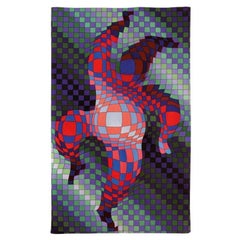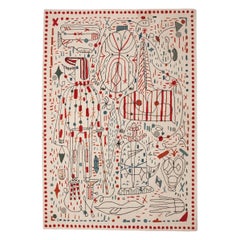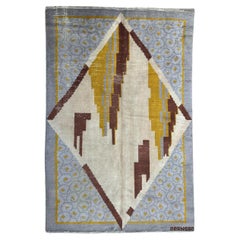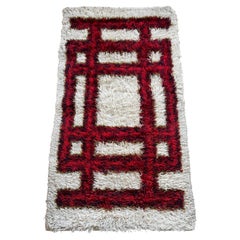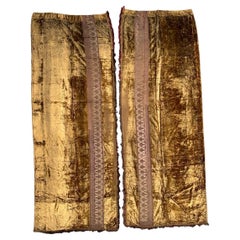Europe - Western European Rugs
to
865
Width
to
Length
to
2,255
1,349
40
1,400
278
98
70
15
11
9
7
6
4
4
2
1
1
1
22
165
1,162
2,295
139
600
392
13
8
32
41
36
58
83
131
52
85
3,312
2,695
627
506
181
3,644
3,624
3,644
1,739
2,260
2,420
1,093
1,022
1,005
700
311
122
103
66
40
Item Ships From: Europe
Victor Vasarely, Hand Signed Original Tapestry
By Victor Vasarely
Located in Geneve, CH
Victor Vasarely (1906-1997).
Panderlak,
circa 1983
Measures: 120 x 72 cm
Hand signed and numbered on the back, edition of 320.
Victor Vasarely, whose original name was Gyözö ...
Category
1980s French Modern Vintage Europe - Western European Rugs
Materials
Wool
$14,277 / item
Small 'Hayon x Nani' Hand-Tufted Rug by Jaime Hayon for Nanimarquina
By Sybilla, Nanimarquina
Located in Glendale, CA
Small 'Hayon x Nani' Hand-Tufted Rug by Jaime Hayon for Nanimarquina.
Executed in 100% hand-tufted New Zealand wool. The 'Hayon x Nani' collection faithfully encapsulates the whimsi...
Category
21st Century and Contemporary Spanish Mid-Century Modern Europe - Western European Rugs
Materials
Wool
Hojer Eksport mid-century wool carpet: "Symphony" Denmark
By Hojer Eksport Wilton
Located in Zemst, BE
A Höjer Eksport Wilton carpet, Denmark
Named: "Symphony"
Made in 100% wool
140*200 cm
fine condition, some really slight decoloration.
This carpet has been professionally clean...
Category
Mid-20th Century Danish Mid-Century Modern Europe - Western European Rugs
Materials
Wool
Very beautiful original french art deco rug by Cransac
Located in Saint Ouen, FR
Nice 1930´s French art deco rug with the inspiration of the name of the artist «Cransac » with a beautiful geometrical art deco design and pretty colours in the hues of sky blue, yel...
Category
1930s French Art Deco Vintage Europe - Western European Rugs
Materials
Wool, Cotton
$4,359 Sale Price
20% Off
No. 2 Danish Modern Pop Art Wool Rya Rug by Hojer Eksport Wilton, 1960s, Denmark
By Hojer Eksport Wilton
Located in Kirchlengern, DE
Article:
high pile rya rug
Origin:
Denmark
Producer:
Hojer Eksport Wilton, Denmark
Description:
this rug is a great example of 60s pop art interior. made in high quali...
Category
Mid-20th Century Danish Mid-Century Modern Europe - Western European Rugs
Materials
Wool
Very Beautiful Antique Pair of silk velvet Curtains
Located in Saint Ouen, FR
Wonderful pair of curtains from late 19th century, with a nice silk velvet tissue and a needlepoint band applied on it.
Size of each piece is 105x295 cm
✨✨✨
"Experience the epitome o...
Category
Late 19th Century French Napoleon III Antique Europe - Western European Rugs
Materials
Silk
$2,151 Sale Price
20% Off
Pretty Vintage French Hand Printed Tapestry Titled "the danse"
Located in Saint Ouen, FR
Nice 20th century French tapestry, in style of Aubusson tapestries, with a design of a medieval museum tapestry called « La Danse » ( The Danse) and beautiful colors, hand printed on...
Category
Mid-20th Century French Aubusson Europe - Western European Rugs
Materials
Cotton
$1,452 Sale Price
20% Off
Large mid century French Cogolin rug
Located in Saint Ouen, FR
Beautiful mid century French Cogolin rug with a nice decorative and simple design, with a white pile of design on the orange foundation, hand made by wool on wool foundation
Damage...
Category
Mid-20th Century French Art Deco Europe - Western European Rugs
Materials
Wool
$3,331 Sale Price
20% Off
Rollakan Hilma Wool Rug Meadow
Located in Stockholm, SE
A collection that celebrates traditional Scandinavian women’s craftsmanship, inspired by Swedish folk traditions in a modern contemporary interpretation. With its patterns and techni...
Category
2010s Indian Modern Europe - Western European Rugs
Materials
Jute
$588 / item
Circular Metamorphosis Wool and Art Silk Rug FB Collection
By Franco Bianchini
Located in Milan, IT
A wavy and earth-toned pattern in opposite sections of this wool and artificial silk rug add a touch of color and elegance. A designer logo and cotton backing complete this beige rug...
Category
2010s Italian Europe - Western European Rugs
Materials
Wool, Silk
Nice modern French Aubusson Tapestry by « Lartigaud »
Located in Saint Ouen, FR
Discover the elegance of modern French tapestry with the exquisite "Floride" (Florida) design by Jean Michel Lartigaud. This limited edition masterpiece, woven in vibrant shades of o...
Category
Mid-20th Century French Modern Europe - Western European Rugs
Materials
Wool, Cotton, Silk
$3,356 Sale Price
20% Off
Pretty Mid Century French Aubusson style Jacquard Tapestry.
Located in Saint Ouen, FR
Elevate your space with this exquisite Aubusson-style tapestry featuring a romantic depiction of a loving couple in the countryside, nestled under a tree. Sheep graze nearby, and a g...
Category
Mid-20th Century French Aubusson Europe - Western European Rugs
Materials
Wool, Cotton
$1,452 Sale Price
20% Off
20th Century Yellow Pink Green Flowers Arraiolos Rug from Portugal, circa 1900s
Located in Firenze, IT
The making of carpets in Portugal dates back to the Renaissance period using the braid stitch, embroidered on large hemp tea towels with the needle. The Portuguese carpet is called A...
Category
Early 20th Century Portuguese Europe - Western European Rugs
Materials
Wool
Bobyrug’s Pretty Antique French Jaquar Tapestry
Located in Saint Ouen, FR
Very beautiful late 19th century tapestry with beautiful design of a hunter at the town, and beautiful golden colors, mechanical Jaquar manufacturing woven with wool and cotton.
✨✨✨...
Category
Late 19th Century French Aubusson Antique Europe - Western European Rugs
Materials
Wool, Cotton
$1,452 Sale Price
20% Off
Jaime Hayon 'Troupe' Rug for Nanimarquina
By Nanimarquina, Jaime Hayon
Located in Tilburg, NL
Jaime Hayon 'Troupe' Rug for Nanimarquina. New, current production. 170 x 240cm.
Crazy, dreamlike and with a sense of humor, resembling a party: such is Jaime Hayon's new collecti...
Category
21st Century and Contemporary Spanish Mid-Century Modern Europe - Western European Rugs
Materials
Wool
Tappeto Iconico Design Italiano Contemporaneo Blu by Deanna Comellini 200x300 cm
By Deanna Comellini
Located in Bologna, IT
"Kama" è un tappeto rivoluzionato entrato nella storia del design firmato Deanna Comellini, fondatrice e Art Director dell'azienda pioniere del tappeto contemporaneo G.T.DESIGN.
"Ka...
Category
2010s Indian Modern Europe - Western European Rugs
Materials
Other
Bubbles Colourful Modern Irregular Circle Rug Large Size
By Sonya Winner
Located in London, GB
Bubbles is a multicoloured area rug entirely handmade in pure wool by artisan weavers, playfully using colour as if it is made of translucent paper. This natural wool area rug is a p...
Category
2010s British Modern Europe - Western European Rugs
Materials
Wool
Rug in style Napoleon III French Aubusson Manufactury, 2m70x3m70- N° 1527
Located in Paris, FR
Rug in Napoleon III style, Aubusson factory - 2m70x3m70 - No. 1527
Period: 20th century
Style: Napoleon III
Condition: Perfect condition
Material: Wool
Length: 270 cm
Width: 370 cm
D...
Category
1980s Vintage Europe - Western European Rugs
Materials
Wool
Wonderful Vintage French Aubusson style Hand Printed Tapestry “ country concert”
Located in Saint Ouen, FR
Concert Champêtre ( country concert )
Very beautiful mid century French Aubusson style tapestry with a beautiful 15th century tapestries design showing a scene in the countryside, ou...
Category
Mid-20th Century French Aubusson Europe - Western European Rugs
Materials
Wool, Cotton
$2,379 Sale Price
20% Off
Very beautiful vintage French Cogolin rug Aubusson design
Located in Saint Ouen, FR
Nice mid century French Aubusson style Cogolin rug with beautiful floral design and nice colours , entirely hand knotted with wool on cotton foundation
✨✨✨
"Experience the epitome ...
Category
Mid-20th Century French Aubusson Europe - Western European Rugs
Materials
Wool, Cotton
$1,760 Sale Price
20% Off
Märta Måås-Fjetterström, "Mossbotten" hand-woven tapestry
Located in London, GB
Swedish, designed c.1930s
Linen warp, wool and linen weft, mounted on an upholstered frame
Category
Early 20th Century Europe - Western European Rugs
Materials
Wool, Linen
Mid-19th Century French Aubusson Manufactory Rug - Dim: 3m35x2m55 - N° 1532
By Aubusson Manufacture
Located in Paris, FR
Artist: Aubusson Manufactory, 19th Century
Era: 19th Century
Condition: Perfect
Material: Wool
Length: 255 cm
Width: 335 cm
Depth: 1 cm (with doubler)
This magnificent rug, having b...
Category
Mid-19th Century French French Provincial Antique Europe - Western European Rugs
Materials
Wool, Silk
Nice Vintage Aubusson Style Jaquar Tapestry
Located in Saint Ouen, FR
Beautiful Aubusson style tapestry with nice design with a gallant scene and nice colors, mechanical Jaquar manufacturing with wool and cotton.
Size: 100 x 140 cm.
Category
Mid-20th Century French Aubusson Europe - Western European Rugs
Materials
Wool
$847 Sale Price
20% Off
Pretty Vintage Aubusson Style médiéval design Jacquard Tapestry « deer chase »
Located in Saint Ouen, FR
very beautiful Aubusson style tapestry, with a design of a medieval tapestry representing « deer chase» (poursuite du cerf), with Beautiful colours with green background, pink, yell...
Category
Mid-20th Century French Aubusson Europe - Western European Rugs
Materials
Wool, Cotton
$1,713 Sale Price
20% Off
Pretty antique tapestry cardboard hand painted panel
Located in Saint Ouen, FR
Pretty 19th century French tapestry cardboard with a nice design of swing game featuring a young man standing pushing a young girl sitting on the swing. At a setting in the woods, be...
Category
Late 19th Century French Romantic Antique Europe - Western European Rugs
Materials
Cotton, Linen
$2,474 Sale Price
20% Off
Pretty vintage French Aubusson style hand printed tapestry, medieval design
Located in Saint Ouen, FR
"Experience the timeless elegance of this exquisite French Aubusson style tapestry, capturing the essence of an 15th century tapestry with a design titled « bord de L’eau » (water's...
Category
Mid-20th Century French Aubusson Europe - Western European Rugs
Materials
Wool
$1,884 Sale Price
20% Off
Bobyrug’s Pretty Vintage French Jaquar Tapestry
Located in Saint Ouen, FR
Nice french Aubusson style tapestry with beautiful design of nature and town, and nice colors, woven by mechanical Jaquar manufacturing with wool and cotton.
✨✨✨
"Experience the epi...
Category
Mid-20th Century French Aubusson Europe - Western European Rugs
Materials
Wool, Cotton
$1,380 Sale Price
20% Off
Bobyrug’s Pretty mid century Brutalist Macrame tapestry town design
Located in Saint Ouen, FR
Introducing a Modern Design meets Neo Classic with a touch of Bohemian flair! Elevate your space with our exquisite macramé hangings. Crafted from natural materials like cotton rope ...
Category
Mid-20th Century Spanish Modern Europe - Western European Rugs
Materials
Wool, Cotton
$2,404 Sale Price
20% Off
Pretty vintage French Aubusson style Jacquard Tapestry « Hunting with hounds »
Located in Saint Ouen, FR
"Discover the timeless elegance of this exquisite vintage French tapestry featuring a hunting with hounds scene.
A noble pastime and a favorite pastime of the great men of the time,...
Category
Mid-20th Century French Aubusson Europe - Western European Rugs
Materials
Wool, Cotton, Acrylic
$1,380 Sale Price
20% Off
1970s design rug, Dal Lago manufactory, Venice
Located in Milano, Lombardia
Wool/acrylic blend rug with informal gray-based pattern with black, red, yellow and white. Typically 60s/70s, this item is a stock item, never used. We have had it cleaned and theref...
Category
1970s Italian Mid-Century Modern Vintage Europe - Western European Rugs
Materials
Wool, Acrylic
Vintage Circular beige, brown and turquoise Wool Rya Rug
By Desso
Located in Vienna, AT
Large Circular Danish modern rya rug labeled Norsk for British carpet centre, Axminster, England. 100% wool.
Charming colours in creamy beige, blue and turquoise, very decorative...
Category
1970s Danish Mid-Century Modern Vintage Europe - Western European Rugs
Materials
Wool
Pretty Mid Century French Aubusson style Jacquard Tapestry, « by Goya »
Located in Saint Ouen, FR
Very pretty mid century french Aubusson style tapestry with beautiful design from the painter « Francisco de Goya (1775-1792) for the royal manufactury of Tapestry »
Tapestry crafte...
Category
Mid-20th Century French Aubusson Europe - Western European Rugs
Materials
Wool, Cotton
$1,380 Sale Price
20% Off
Pretty Vintage Aubusson Style medieval museum design Jacquard Tapestry
Located in Saint Ouen, FR
very beautiful Aubusson style tapestry, with a design of a medieval Rhenish tapestry (1480-1490) Basel (Switzerland), representing a royal court of France, the arms of France, with b...
Category
Mid-20th Century French Aubusson Europe - Western European Rugs
Materials
Wool, Cotton
$1,865 Sale Price
20% Off
Ethel Halvar-Andersson — Hand-Knotted Geometric Carpet, Sweden, 1940s
By Ethel Halvar Andersson
Located in Brussels, BE
Ethel Halvar-Andersson — Hand-Knotted Geometric Carpet, Sweden, 1940s
Signed “EHA”
Dimensions: approx. 242 x 178 cm (95.3 x 70.1 in)
Designer: Ethel Halvar-Andersson (1917–2011)
Ori...
Category
1940s Swedish Mid-Century Modern Vintage Europe - Western European Rugs
Materials
Wool
Desert Sand Earth Bamboo Carpet by Massimo Copenhagen
Located in Geneve, CH
Desert sand earth bamboo carpet by Massimo Copenhagen
Handwoven
Materials: 50% New Zealand Wool, 50% Bamboo
Dimensions: W 300 x H 400 cm
Available colors: Nougat Rose, Cashmere, ...
Category
2010s Danish Post-Modern Europe - Western European Rugs
Materials
Wool, Bamboo
Stunning Handmade Space Age Wool Carpet, 1970s Germany
Located in Nürnberg, Bayern
Stunning handmade Space Age wool carpet, 1970s Germany.
Has been professionally cleaned. The colour shines incredibly beautiful. A stunning carpet from the 1970s in very good cond...
Category
1970s German Mid-Century Modern Vintage Europe - Western European Rugs
Materials
Wool
Pretty Vintage Aubusson Style Jaquar Tapestry “fountain rest “
Located in Saint Ouen, FR
Very pretty mid century French tapestry with nice galant design titled “Repos Fontaine” (Fontain Rest) and beautiful colors, woven with mechanical Jaquar looms with wool, acrylic and...
Category
Late 20th Century French Aubusson Europe - Western European Rugs
Materials
Wool, Cotton
$1,199 Sale Price
20% Off
Nice antique distressed European rug oushak design
Located in Saint Ouen, FR
Beautiful early 20th century large European rug with a design of the antique Turkish oushak rugs and nice colours with a red background and green, purple, brown, yellow and white, en...
Category
Early 20th Century European Oushak Europe - Western European Rugs
Materials
Wool, Cotton
$2,151 Sale Price
20% Off
Pair of French Art Deco Rugs Designed by Jean Burkhalter for Pierre Chareau
By Jean Burkhalter
Located in Milan, IT
An extremely rare Art Deco rug designed in 1925 by Jean Burkhalter and commissioned by Pierre Chareau for a seaside mansion on the island of Corsica....
Category
1920s French Art Deco Vintage Europe - Western European Rugs
Materials
Wool
Dash 400 Rug by Illulian
Located in Geneve, CH
DASH 400 Rug by Illulian
Dimensions: D400 x H300 cm
Materials: Wool 50%, Silk 50%
Variations available and prices may vary according to materials and sizes. Please contact us.
...
Category
2010s Italian Post-Modern Europe - Western European Rugs
Materials
Silk, Wood
$36,193 / item
Bobyrug’s Nice Antique French Hand Printed Lurçat Signed Tapestry
Located in Saint Ouen, FR
Very beautiful antique french hand printed tapestry with nice design of Jean Lurçat, with a signature printed on the design of the tapestr...
Category
Mid-20th Century French Art Deco Europe - Western European Rugs
Materials
Wool, Cotton
$2,474 Sale Price
20% Off
Residue Wool Rug Bone White
Located in Stockholm, SE
Residue Bone White Rug is a unique, big rug with one organic stripe that makes a difference in the height. With its structured wool and the high and low cut, Residue can be an art pi...
Category
2010s Indian Modern Europe - Western European Rugs
Materials
Wool
$2,730 / item
Italian Vintage Rug Mat by G.T. Design
Located in Alessandria, Piemonte
S/28 - One of the first rug mats by G.T. Design, dating back to the late 1980s.
Now in liquidation (its true cost of many years ago) because I'm closing activities.
Category
Late 20th Century Italian Modern Europe - Western European Rugs
Materials
Wool, Cotton
Pretty Vintage French Aubusson Style hand printed Tapestry by “Roga”
Located in Saint Ouen, FR
Pretty vintage tapestry by Roga, with a nice design titled “concert champêtre” (country concert), showing three characters playing music, in the countryside, near a river, behind, we...
Category
Mid-20th Century French Aubusson Europe - Western European Rugs
Materials
Cotton
$1,452 Sale Price
20% Off
Zoom Ivy Wool And Viscose Rug by Sitap Carpet Couture Italia
By Sitap Carpet Couture
Located in Milan, IT
The Zoom carpet by Camilla Bellini for SITAP Carpet Couture Italia features a stylized floral design in luxurious wool and viscose with a unique three-dimensional effect. Handloomed ...
Category
2010s Italian Europe - Western European Rugs
Materials
Wool
Pretty antique 17th century French Aubusson Tapestry fragment
Located in Saint Ouen, FR
"Exquisite fragment of a border of a French Aubusson tapestry from the middle of the 17th century, featuring a beautiful design of flowers and nice natural colours, entirely hand wov...
Category
Mid-17th Century French Aubusson Antique Europe - Western European Rugs
Materials
Wool, Silk
$618 Sale Price
20% Off
Important AUBUSSON Tapestry "Agamemnon Victorious" Early 20th Century
By Aubusson Manufacture
Located in Madrid, ES
Important AUBUSSON Tapestry "Agamemnon Victorious Distributing the Booty to the Greeks" Early 20th Century
Polychrome wool tapestry with a central historiated scene within a border o...
Category
Early 20th Century French Modern Europe - Western European Rugs
Materials
Wool
Antique french Needlepoint Panel or border Tapestry
Located in Saint Ouen, FR
Beautiful late 19th century needlepoint tapestry in the form of a stripe or border fragment, with nice floral design and beautiful colours, entirely hand embroidered with needlepoint...
Category
Late 19th Century French Aubusson Antique Europe - Western European Rugs
Materials
Wool, Silk
$2,151 Sale Price
20% Off
Cassina Atacama Rugs Cenere
By Cassina
Located in Barcelona, Barcelona
Cassina Atacama Rugs Cenere
Atacama is a modern, versatile design carpet made of viscose, an excellent choice for any interior decor project.
The rugs in this series have a brillia...
Category
2010s Italian Mid-Century Modern Europe - Western European Rugs
Materials
Synthetic
$10,498 Sale Price / item
20% Off
Pretty vintage French Aubusson style hand printed tapestry medieval design
Located in Saint Ouen, FR
"Experience the timeless elegance of this exquisite French Aubusson style tapestry, capturing the essence of an 15th century Flanders tapestry with a design titled « La battue » (the...
Category
Mid-20th Century French Aubusson Europe - Western European Rugs
Materials
Wool, Cotton
$1,884 Sale Price
20% Off
Bobyrug’s Pretty antique french art nouveau round rug
Located in Saint Ouen, FR
Very nice antique french round rug from early 20th century, with a beautiful floral art nouveau design from an artist of the period, entirely hand knotted with wool on jute foundation
Category
1920s French Art Nouveau Vintage Europe - Western European Rugs
Materials
Wool, Jute
$3,102 Sale Price
20% Off
20th Century Swedish Rag Rug
Located in Tetbury, Gloucestershire
20th Century Swedish rag rug. Featuring a stripe design in multiple tones. This rug is machine washable at 30 degrees.
RT6024588
Category
Mid-20th Century Swedish Europe - Western European Rugs
Materials
Cotton
Rare Danish Ege Axminster rug - Vincent van Gogh "Olive Trees" in wool
By Ege Axminster A/S, Vincent van Gogh
Located in Firenze, FI
Danish carpet made by Ege Axminster A/S - Denmark for the 20th century masters carpet collection. label on back Licensed by: Van Gogh International B.V. in 1995 Design No. 80583 rug ...
Category
1990s Danish Europe - Western European Rugs
Materials
Wool
Contemporary Handwoven Flat-Weave Wool Kilim Rug Black White Gold Geometric
Located in Madrid, ES
This rug has been ethically handwoven in the finest wool yarns by artisans in north of India, using a traditional weaving technique which is native of this region.
Each rug is handwo...
Category
21st Century and Contemporary Indian Modern Europe - Western European Rugs
Materials
Wool, Cotton
Begüm Cana Özgür 'Haze 4' Runner Rug 80x240cm for Nanimarquina
By Nanimarquina
Located in Tilburg, NL
Begüm Cana Özgür 'Haze 4' Runner Rug 80x240cm for Nanimarquina. New, current production.
Haze emerges from the reflection on the meaning of contrast and harmony that arises in the c...
Category
21st Century and Contemporary Spanish Modern Europe - Western European Rugs
Materials
Wool
Alice Crawley Bamboo Forrest Wool Rug Blue
Located in Stockholm, SE
Alice Crawley Bamboo Wool Rug is part of the design collaboration Alice Crawley x LAYERED. The rugs are made of 100% wool with a cut pile for a sharp and clean finish. The colors hav...
Category
2010s Indian Modern Europe - Western European Rugs
Materials
Wool
$1,778 / item
'Lineal Flow' Handmade Rug by Linie Design, 240 cm, Wool & Silk
By Linie Design
Located in Paris, IDF
Lineal Flow, 'Axiom' collection by Linie Design
Rectangular handmade rug.
Materials: 85% New Zealand Wool / 15% Silk
Hand knotted rug
Dimensions: 170 cm x 240 cm
An artistic and ...
Category
21st Century and Contemporary Indian Scandinavian Modern Europe - Western European Rugs
Materials
Wool, Silk
Pretty mid century Brutalist Macrame tapestry boats design
Located in Saint Ouen, FR
Introducing a Modern Design meets Neo Classic with a touch of Bohemian flair! Elevate your space with our exquisite macramé hangings. Crafted from natural materials like cotton rope,...
Category
Mid-20th Century Spanish Modern Europe - Western European Rugs
Materials
Wool, Cotton
$2,722 Sale Price
20% Off
Nice French Art Deco Paul Née Rug
Located in Saint Ouen, FR
Very beautiful Art Deco design modern French hand knotted rug with signature of artist Paul Née, circa 1980, entirely hand knotted with wool velvet...
Category
Late 20th Century French Art Deco Europe - Western European Rugs
Materials
Wool
$4,759 Sale Price
20% Off
1970s Wool Tapestry, Poland
Located in Praha, CZ
- Good original condition with minor signs of use
Category
1970s Polish Mid-Century Modern Vintage Europe - Western European Rugs
Materials
Wool
Recently Viewed
View AllMore Ways To Browse
Tiffanys Persian
Tiger Maple Chest
Tondo Doni
Totem Pacific Northwest
Trolls Vintage
Tv Cart
Used Christmas Dishes
Used Corian
Used Furniture Burbank Ca
Used Marquee Signs
Used Metal Queen Size Bed Frame
Used Shaving Brush
Used Shriner Rings
Val St Lambert Pink
Vase Stork
Vases 3 Feet Tall And Taller
Vault Handle
Vellum Cabinet
